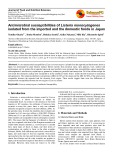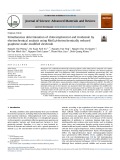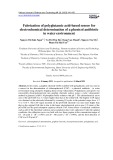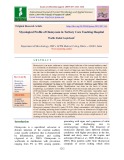
Chloramphenicol determination
-
In vitro antimicrobial susceptibility of Listeria monocytogenes isolated from the imported and the domestic foods in Japan was determined by plate dilution method. Eleven isolates from domestic meat, meat products, liver, seafood and environment, and 16 isolates from imported meat and meat products were examined their susceptibilities against ampicillin, chloramphenicol, enrofloxacin, erythromycin, gentamicin, kanamycin, penicillin and tetracycline.
 4p
4p  viisac
viisac
 23-09-2023
23-09-2023
 2
2
 1
1
 Download
Download
-
Manganese (IV) oxide/electrochemically reduced graphene oxide (MnO2/ErGO) composite was synthesized in an oxidation-reduction process followed by electrochemical reduction. The obtained materials were characterized with X-ray diffraction (XRD), electrochemical impedance spectroscopy (EIS), and scanning electron microscopy (SEM) with energy-dispersive X-ray mapping (EDX mapping).
 16p
16p  viberbers
viberbers
 09-08-2023
09-08-2023
 4
4
 3
3
 Download
Download
-
In this study, a graphite electrode (GrE) modified with polyglutamic acid was used as a sensor for the determination of chloramphenicol (CAP) - a phenicol antibiotic - in water environment using adsorptive stripping linear sweep voltammetry.
 13p
13p  viannee
viannee
 02-08-2023
02-08-2023
 7
7
 3
3
 Download
Download
-
Otomycosis is an acute, subacute or chronic fungal infection of the external auditory canal. It is worldwide in distribution with a higher prevalence in the hot, humid, and dusty areas of the tropics and subtropics. A wide variety of fungi can cause Otomycosis. In this study, our aim was to determine the most common mode of presentation, predisposing factors, and the spectrum of fungi involved in Otomycosis. 60 Ear discharge samples were collected aseptically using two sterile cotton swabs. One swab was used for direct microscopic examination and used for fungal culture.
 5p
5p  trinhthamhodang3
trinhthamhodang3
 12-02-2020
12-02-2020
 9
9
 0
0
 Download
Download
-
The antibacterial activity of Betel leaf was studied to screen their ability to inhibit the growth of bacterial pathogens i.e. E. coli, B. cereus, P. aeruginosa and S. typhi. The organisms were subjected to antibiotic sensitivity towards, Ampicillin, Chloramphenicol, Penicillin, Rifampicin, Gentamycin, Tetracycline, Ciprofloxacin, Norfloxacin, Kanamycin, Azithromycin, Ceftazidine, Amikacin, Ofloxacin, Vancomycin and Teicoplanin. S.typhi was the most susceptible organism towards all the tested antibiotics. E. coli, B. cereus and P. aeruginosa were multidrug resistant organisms.
 11p
11p  kequaidan2
kequaidan2
 13-12-2019
13-12-2019
 12
12
 0
0
 Download
Download
CHỦ ĐỀ BẠN MUỐN TÌM

















